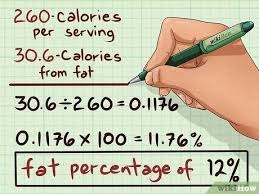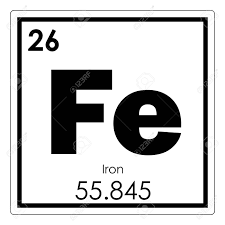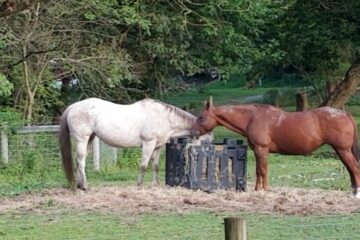Protein, Fat and Carbs; The Equine Energy Trinity

I really wanted to focus on fat for this article but it is impossible to discuss the role of fat in a horse’s diet without looking at the major sources of energy that play a role in selecting a diet for a horse.
The reason I wanted to focus on fat is that supplemental fat seems to be the default “go to” for weight gain and maintenance and my experience shows me that this is a misguided route to follow for weight management.
Owners sometimes focus on calories as a measure for their choice of feeds. “Skinny horses need more calories and fat horses not so much”. While this is certainly true not all calories are created equally so nutritionists tend to look at the source of those calories to determine “energy”
Energy Versus Calories
Calories are determined by burning a material and measuring the temperature reached by the combustion. Testing sawdust will yield a very high calorie count but feeding sawdust to your horse will not add much to weight gain or performance. This is an extreme example but I used it to point out that all calories are not created equally and the source of the calories matter.
Fat provides about 9 calories per gram while protein and carbs offer 4 per gram. It’s obvious that fat is a great source of calories compared to protein and carbohydrates but it’s how those calories are used that makes a difference.
A good analogy that is easily understood by anyone who drives a vehicle would be to compare carbohydrates to gasoline, fat to diesel fuel and protein to lubricants.
Carbs provide ready energy for sports cars like thoroughbreds, quarter milers and cutting horses. Lots of speed but not for long.
Fat provides sustained energy for vehicles that need good mileage for long, quiet trips. Endurance horses and warmbloods for dressage, eventing, jumping, etc.
Protein is what keeps the vehicle running by rebuilding muscle, bone, hooves, etc.
Workload Determines the Best Energy Source
Wild horses don’t get supplemental feeds and do quite well on scrubby plains grasses so why are we supplementing our horses? The answer is breeding and workload.
My three AQH mares have no work to do since they are retired. They have no problem maintaining weight on good hay. A balancer is provided to fill in any gaps in the forage so that they live to be 106 and destroy my retirement savings. That’s another story.
Regardless of source all energy is delivered to the muscles in the form of glucose converted to glycogen that is “burned” when the muscles demand it for exercise.
Carbohydrates provide a readily available source of glucose to be converted to glycogen as it is rapidly depleted by your barrel horse running the cloverleaf.
Fat takes longer to convert to glucose but will provide a steady supply of energy for your endurance horse. Fat calories are also “cooler” calories so your English Pleasure class doesn’t turn into a rodeo of bedlam.
Balancing Energy Sources
Any professional or high level amateur competitor will have a fairly strong grasp of performance and energy requirements for their horses. These owners want their horses to look good but at the end of the day it’s about how well they perform their chosen event.
The majority of horse owners aren’t competing at a high level if at all and are more concerned with their horse’s weight and condition. Let’s take a look at how energy works for the rest of us when it comes to feeding our horses.
Oil and fat supplements were very common choices years ago before high tech high fat feeds were recently introduced.
Anyone who has been around feeds for some time remembers when the protein to fat ratio was around two to one. We referred to feeds as “12-6”, “12-3” or “14-7”. The primary reason for this two to one ratio is that fat has twice the calories as protein so the calories in the feed were somewhat balanced.
This ratio works well for horses that are healthy and getting their full portion of forage daily. For our porkers the ratio in balancer is around 12 to 1 protein to fat since they are converting all the forage to fat already
About the only high fat feed for years was a “triple ten”. Ten percent protein, ten percent fiber and ten percent fat. This feed is still around and still does the same job. Triple ten puts weight on horses for a value price. You’ll find it in some boarding barns.
When the only concentrated feeds available contained high carbohydrates and low fat the endurance riders had no choice but to introduce supplemental fat to get the job done.
High fat concentrated feeds are a challenge to produce since fat changes the consistency of the materials in making feed as well as stabilizing the fats to remain fresh while being stored.
Another challenge for high fat feeds is the calorie imbalance with protein. Feeding a 12% protein and 12% fat feed means a horse will be getting twice the fat calories and half the protein calories per pound. This results in a horse with good weight but poor muscle definition and topline. Protein will never catch up with fat in this situation.
The solution to this problem is a very high quality amino acid profile making the protein available much more efficient. All high fat feeds are not created equally.
One of my favorite value feeds is Nutrena Fiber Plus. You just can’t beat this feed for the price of a bag. Fiber Plus is a 12% protein, 10% fat feed that is low carb. If you open a bag of Nutrena ProForce Fuel alongside a bag of Fiber Plus you would be hard pressed to tell the difference. The two feeds look, feel and smell almost identical.
ProForce Fuel is a 13% protein, 13% fat feed with a very high tech amino acid package providing a great feed for a 1,600 pound warmblood eventer that provides excellent topline and muscle recovery performance.
Fiber Plus will keep your backyard lesson horse round and shiny with an OK topline. If you start putting this horse to serious work the feed won’t hold up because it simply doesn’t have the amino acid support to make it stick.
With the introduction of these high tech high fat feeds the need for an owner to offer supplemental fat calories is redundant.
Fat for Weight Management
If you want to send me scurrying to the liquor cabinet for a dose of self medication, mention providing supplemental fat to put weight on a horse.
“My horse is skinny!”
“Give him corn oil!”
This conversation will invariably give me a craving for bourbon and a Lucky Strike.
I’ve written a complete article on feeding “hard keepers” so I won’t go into the whole thing here but throwing fat at a skinny horse isn’t the way to go. Here’s why;
Horses don’t have access to concentrated fat in their natural diet. This to the extent that nature omitted a gallbladder for them since they don’t naturally have a need for concentrated bile to break down fats.
The natural source for fat in horses comes from the fermentation of fiber in the hindgut. This process liberates volatile fatty acids for the horse to use and store.
A horse will learn to process fat as a calorie source by adapting its metabolism over a few months but the better way is to fix the root problem and provide unlimited forage for calories. Providing supplemental fat or an overload of any supplemental calorie source to an underweight horse is masking an underlying problem that needs to be fixed.
When is Supplemental Fat Appropriate?
Horses with special conditions making them sensitive to carbohydrates benefit from calories derived from supplemental fat.
Letter conditions like EMS, PPID and PSSM1 horses who may be limited in their access to calories from forage are candidates for fat calories if they are required to maintain weight.
Other than those few specific cases the better option is to turn to a quality formulated high fat feed to meet the needs of the horse.
Forage First
Forage (hay, pasture, replacements) should be the primary source of calories for your horse since nature has designed the system to process forage for optimal energy management.
When workload and environment call for more energy that forage provides then we call on supplemental feeds to get the job done. These days there are unlimited feed formulations available to meet every situation so we no longer have to guess at how much or with what to supplement equine diets.


